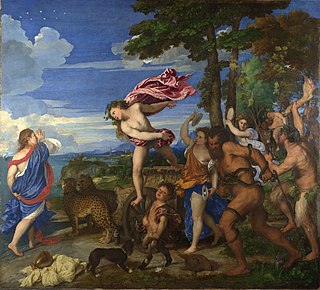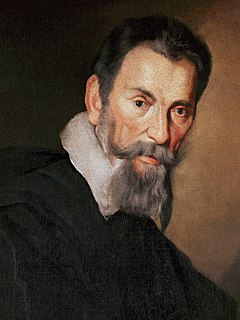Related Research Articles
The year 1600 in music involved some significant events.

L'Orfeo, sometimes called La favola d'Orfeo[la ˈfaːvola dorˈfɛːo], is a late Renaissance/early Baroque favola in musica, or opera, by Claudio Monteverdi, with a libretto by Alessandro Striggio. It is based on the Greek legend of Orpheus, and tells the story of his descent to Hades and his fruitless attempt to bring his dead bride Eurydice back to the living world. It was written in 1607 for a court performance during the annual Carnival at Mantua. While Jacopo Peri's Dafne is generally recognised as the first work in the opera genre, and the earliest surviving opera is Peri's Euridice, L'Orfeo is the earliest that is still regularly performed.
Emilio de' Cavalieri, or Emilio dei Cavalieri—the spellings "del" and "Cavaliere" are contemporary typographical errors—(c. 1550 – 11 March 1602) was an Italian composer, producer, organist, diplomat, choreographer and dancer at the end of the Renaissance era. His work, along with that of other composers active in Rome, Florence and Venice, was critical in defining the beginning of the musical Baroque era. A member of the Roman School of composers, he was an influential early composer of monody, and wrote what is usually considered to be the first oratorio.

Giulio Romolo Caccini was an Italian composer, teacher, singer, instrumentalist and writer of the late Renaissance and early Baroque eras. He was one of the founders of the genre of opera, and one of the most influential creators of the new Baroque style. He was also the father of the composer Francesca Caccini and the singer Settimia Caccini.

Francesca Caccini was an Italian composer, singer, lutenist, poet, and music teacher of the early Baroque era. She was also known by the nickname "La Cecchina" [la tʃekˈkiːna], given to her by the Florentines and probably a diminutive of "Francesca". She was the daughter of Giulio Caccini. Her only surviving stage work, La liberazione di Ruggiero, is widely considered the oldest opera by a woman composer.
Luca Bati was an Italian Baroque composer and music teacher. One of his pupils was Marco da Gagliano.
Settimia Caccini was a well-known Italian singer and composer during the 1600s, being one of the first women to have a successful career in music. Caccini was highly regarded for her artistic and technical work with music. She came from a family of well-known composers and singers, with her father being Giulio Caccini and her sister Francesca Caccini. Settimia Caccini was less well-known as a composer because she never published her own collection of works. Instead, nine works are attributed to her in two manuscripts of secular songs. Settimia was known much more for her talent as a singer, and she performed for nobility with the Caccini family consort and as a soloist. Coming from a musical family, she was able to lead herself to her own fame and success.

The concerto delle donne was a group of professional female singers in the late Renaissance court of Ferrara, Italy, renowned for their technical and artistic virtuosity. The ensemble was founded by Alfonso II, Duke of Ferrara, in 1580 and was active until the court was dissolved in 1597. Giacomo Vincenti, a music publisher, praised the women as "virtuose giovani", echoing the sentiments of contemporaneous diarists and commentators.
La liberazione di Ruggiero dall'isola d'Alcina is a comic opera in four scenes by Francesca Caccini, first performed 3 February 1625 at the Villa di Poggio Imperiale in Florence, with a libretto by Ferdinando Saracinelli based on Ludovico Ariosto's Orlando Furioso. It is the first opera written by a woman and was long considered to be the first Italian opera to be performed outside of Italy. It was performed to celebrate the visit of Prince Władysław of Poland during Carnival 1625, and it was revived in Warsaw in 1628. The work was commissioned by her employer Regent Archduchess Maria Maddalena of Austria, wife of Cosimo II de' Medici. Ruggiero was printed under the protection of Maria Magdalena in 1625, only five years after the first printed opera in Italy. It is the only opera by Francesca Caccini to survive.
Francesco Rasi was an Italian composer, singer (tenor), chitarrone player, and poet.

L'Arianna is the lost second opera by Italian composer Claudio Monteverdi. One of the earliest operas in general, it was composed in 1607–1608 and first performed on 28 May 1608, as part of the musical festivities for a royal wedding at the court of Duke Vincenzo Gonzaga in Mantua. All the music is lost apart from the extended recitative known as "Lamento d'Arianna". The libretto, which survives complete, was written in eight scenes by Ottavio Rinuccini, who used Ovid's Heroides and other classical sources to relate the story of Ariadne's abandonment by Theseus on the island of Naxos and her subsequent elevation as bride to the god Bacchus.
Euridice is an opera in a prologue and one act by the Italian composer Giulio Caccini. The libretto, by Ottavio Rinuccini, had already been set by Caccini's rival Jacopo Peri in 1600. Caccini's version of Euridice was first performed at the Pitti Palace, Florence, on 5 December 1602. Caccini hurriedly prepared the score for the press and published it six weeks before Peri's version appeared.
The Magnificat Baroque Ensemble, or Magnificat, is an early music ensemble of voices and instruments specializing in the Baroque music of the 17th century under the artistic direction of Baroque cellist Warren Stewart. Stewart founded the ensemble in San Francisco in 1989 with Baroque harpsichordist Susan Harvey. Harvey resigned in 2000, and the group has remained under the sole musical direction of Stewart since then. The group derives its name from the first word of the Latin translation of the Canticle of Mary in the Gospel of Luke, Magnificat anima mea, "My soul magnifies the Lord", which is sung during the Roman Catholic evening prayer or vespers service.
Stefano Venturi del Nibbio was an Italian composer of the late Renaissance, active in Venice and Florence. In addition to composing madrigals in a relatively conservative style, works which were published as far away as England, he collaborated with Giulio Caccini on one of the earliest operas, Il rapimento di Cefalo (1600).
Barbara Russano Hanning is an American musicologist who specializes in 16th- and 17th-century Italian music. She has also written works on the music of 18th-century France and on musical iconography.

La Flora, o vero Il natal de' fiori is an opera in a prologue and five acts composed by Marco da Gagliano and Jacopo Peri to a libretto by Andrea Salvadori. It was first performed on 14 October 1628 at the Teatro Mediceo in Florence to celebrate the marriage of Margherita de' Medici and Odoardo Farnese, Duke of Parma. Based on the story of Chloris and Zephyrus in Book V of Ovid's Fasti, Salvadori's libretto contains many allegorical references to the transfer of political power, the beauty of Tuscany, and the strength of the Medici dynasty. The score of La Flora is one of only two still in existence out of Gagliano's 14 published stage works. Several of its arias are still performed as concert pieces.
Andrea Salvadori was an Italian poet and librettist. He was born in Florence and educated at the Collegio Romano in Rome. From 1616 until his death in Florence at the age of 43, he was the principal court poet to the Medici family. In addition to numerous theatrical entertainments and poems, he wrote the libretti for five operas, four of which have survived, although only La Flora composed by Marco da Gagliano and Jacopo Peri has an extant score. He was married twice, first to Emilia Rigogli by whom he had three sons and then to the painter Alessandra Furini. A collection of Salvadori's principal works curated by his son Francesco was published in 1668.

The Italian composer Claudio Monteverdi (1567–1643), in addition to a large output of church music and madrigals, wrote prolifically for the stage. His theatrical works were written between 1604 and 1643 and included operas, of which three—L'Orfeo (1607), Il ritorno d'Ulisse in patria (1640) and L'incoronazione di Poppea (1643)—have survived with their music and librettos intact. In the case of the other seven operas, the music has disappeared almost entirely, although some of the librettos exist. The loss of these works, written during a critical period of early opera history, has been much regretted by commentators and musicologists.